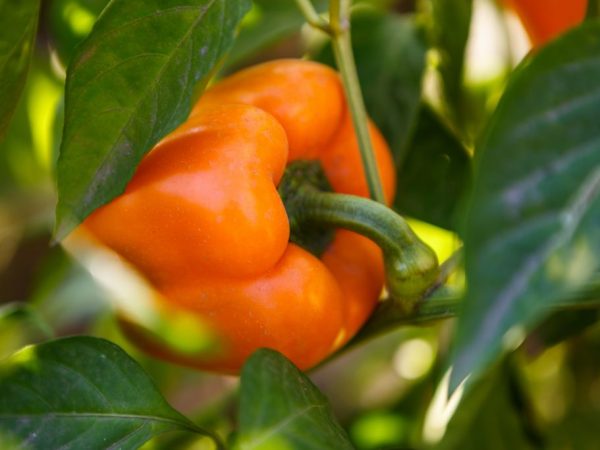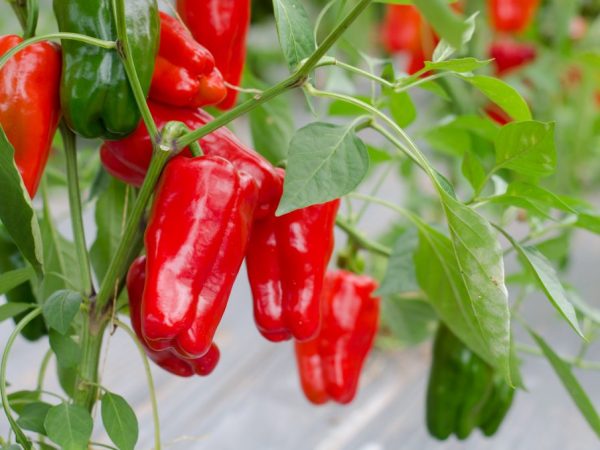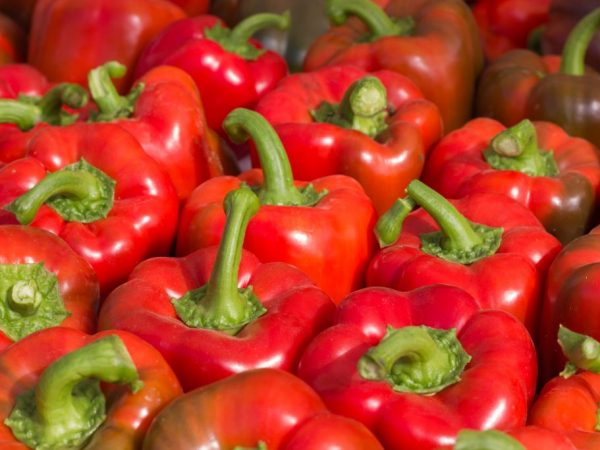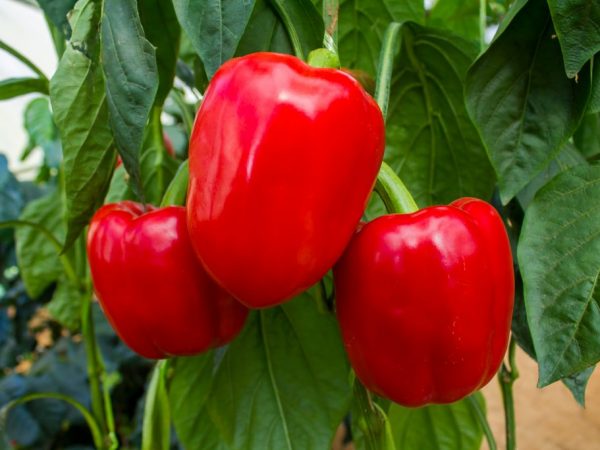Harvest varieties of Siberian peppers
For several years now, work has been underway to develop varieties of vegetable crops that have all the qualities for successful cultivation in areas with difficult climatic conditions. Peppers of Siberian selection, resistant to adverse conditions and high-yielding even in the northern regions, have earned great popularity among experienced gardeners.

Harvest varieties of Siberian peppers
Early varieties of Siberian selection
There is a large number of high-yielding peppers of the Siberian collection among the early maturing ones. They mature in a short, cool summer.
Valentine F1
Valentine is an early hybrid with high yields. The fruits can be harvested in 105-115 days.
Bush
According to the description, the bushes are undersized, reaching a height of 35 cm. This compactness makes it easier to care for plants, and also allows you to grow more bushes in a limited area. For 1 sq. m planted up to 8 plants. The variety is suitable for compacting plantings of indeterminate peppers. The bush is covered with large leaves of deep green color with slight wrinkles.
Up to 20 small fruits directed upwards grow on the bushes.
Fruit
The fruits differ in a number of characteristics:
- elongated conical shape;
- dense shiny skin;
- weighing 50-90 g;
- walls 0.6-0.8 cm thick;
- dark red.
Valentine F1 has a high content of vitamin C-175 mg and glucose, fructose - about 3.2%.
Novosibirsk
Novosibirsk is an early maturing variety of Siberian selection. The fruits reach technical maturity in 92-110 days from the moment of mass germination of seeds. It is suitable for outdoor cultivation.
Bush
The bush is medium-sized, up to 0.9 m high. Powerful, with compact arrangement of branches, erect. On the bushes, 15-20 fruits of equal size with high commercial qualities are tied.
Fruit
The fruits have the following characteristics:
- conical truncated shape;
- smooth, shiny skin;
- wall thickness 5-6 mm;
- weight 100-120 g.
Novosibirsk has excellent yield indicators: from 1 sq. m collect 7-10 kg of high quality fruit.
You can increase the yield of the variety and increase the size of the peppers by growing the crop by forming a bush in 2 main stems. Also, this variety responds well to regular feeding and processing with special growth stimulants.
Siberian prince

The fruits are versatile in use
The Siberian Prince is an early variety, fruitful, with high resistance to adverse weather conditions. Fruits ripen together, evenly after 115-125 days from the moment of emergence. From 1 sq. m, about 5 kg of vegetables are harvested. The variety is suitable for planting in open beds, film tunnels and greenhouses.
Bush
The bush of the variety is medium-sized, with a dense deciduous mass. The stems are resistant to mechanical pressure, the elastic branches return to an upright position when the excess fruit is removed.
Fruit
The fruits are different:
- conical, aligned shape;
- three-, four-chamber;
- surface with a glossy sheen;
- walls 4.5-5 mm;
- weighing up to 150 g;
- color from yellow to red.
The pulp is sweet, firm, crunchy, with a pleasant taste. The fruits are suitable for preservation, salads and drying.
Seeds for seedlings are sown at the end of February, and young plants are transplanted to a permanent place 70-75 days after the threat of frost has passed. Seedlings are planted adhering to the 60 x 40 cm scheme. The variety grows well on loamy drained soils.
Siberian bonus
Siberian bonus is a high-yielding early representative of Siberian selection.
Bushes
Bushes are medium-sized, up to 85 cm, compact, have limited branching. 10-15 fruits are tied on one bush. They begin to ripen 65-70 days after the seedlings are planted in the soil.
Fruit
The fruits have the following characteristics:
- cubic shape;
- smooth, shiny surface;
- the thickness of the mesocarp - 8-12 mm;
- weight - up to 300 g;
- color orange-red, orange.
The pulp is crispy, does not contain capsaicin, therefore it is sweet even in technical maturity.
In a state of technical maturity, the yield reaches 3-3.5 kg per bush. It ripens well already in the assembled state, does not lose its elasticity.
Mid-season peppers of Siberian selection

Varieties will delight you with high yields
The ripening period of medium varieties is about 130-145 days. Mid-season peppers are thick-walled and high yielding. Siberian breeders have developed a number of mid-season varieties with high quality indicators.
Zest
Zest - bell pepper with an average ripening period. Fruits begin to ripen in 130-140 days from the moment of sowing seeds for seedlings. They are suitable for growing outdoors in Siberia and other regions.
The variety is resistant to various diseases, well adapted to low temperatures and lack of lighting.
Bush
Standard type bush. Height - 55-70 cm. The bush is medium-branched, which makes it compact, does not require tying and shaping. 8-12 peppers are formed on each plant.
Fruit
The fruits of the plant have a number of characteristics:
- cylindrical shape;
- the surface is glossy, smooth;
- weight 160-180 g;
- walls 7-9 mm;
- deep yellow color.
The fruits have a pleasant taste and rich aroma, which remains even after heat treatment.
Bagheera
It is a high-yielding mid-season variety with large fruits. Bagheera peppers begin to ripen in 140-145 days from the date of sowing seeds for seedlings.
The culture is grown by seedling method. So that the peppers have time to ripen in the open field, the seeds are sown on the 10th of February.
Bush
Semi-sprawling bushes, undersized up to 55 cm high. Leaves are oval-pointed, green, medium-sized. 6-8 wilted fruits are formed on the bushes during the season.
Fruit
Fruits are characterized by a number of characteristics:
- cubic shape, four-chamber;
- the surface is smooth, shiny;
- the walls are thick, up to 0.9 cm;
- weight up to 320 g;
- color from violet-black to red.
Their pulp is very juicy and aromatic. At the stage of technical maturity, there is a slight spicy note on the palate, the fully ripe fruit is sweet and very pleasant to the taste.
Late-ripening varieties of Siberian selection

The ripening period of fruits depends on the region
The ripening period of varieties of Siberian peppers of the late-ripening category is about 150-155 days from the moment the seeds are planted in the soil.
Marshmallow in chocolate
Marshmallow in chocolate is a unique variety of the Siberian collection, which differs from others in color and sweetness. It belongs to the middle late peppers, which are suitable for greenhouses and open beds. The ripening period of the pepper depends on the region in which the crop is grown. In the southern regions (Krasnodar Territory), fruits appear earlier. In the northern regions, fruiting can be postponed in terms of 15-25 days.
The variety exhibits complex resistance to fungal and viral diseases of nightshade crops.
Bush
The bushes are medium-sized, 65-85 cm high, powerful, with a well-developed root system and a strong central shoot. Due to the large number of peppers being tied, the bush requires a garter to the stakes.
Fruit
The fruits are different:
- clear edges;
- three-chamber;
- thin, delicate skin;
- thick, more than 9 mm walls;
- weighing 180-250 g;
- chocolate brown.
The high sugar content and juiciness make the Marshmallow in chocolate ideal for fresh consumption. The variety is suitable for various types of culinary processing, but it must be borne in mind that when exposed to heat, it loses its beautiful color.
The variety has high transportability and keeping quality.
hippopotamus
The hippopotamus is designed for a different cultivation method. It is a stress-resistant variety with good adaptability to cold temperatures. With temperature changes, the variety does not throw off flowers and does not stop growing fruits. Peppers begin to ripen in 120-130 days from the moment of seed germination.
Bush
The bushes are semi-spreading, medium-sized, up to 0.9-1 m high. 10-15 homogeneous fruits are formed on one bush.
Fruit
The fruits are characterized by:
- cuboid shape;
- 3-4-chamber fruits;
- dense, glossy skin;
- mesocarp (walls) 7-8 mm thick;
- weight 100-120 g;
- color from dark green to deep red.
Peppers for universal culinary purposes with a pleasant taste and good pulp structure.
Conclusion
Thanks to modern science and the works of scientists, such a heat-loving culture as sweet pepper has become available for cultivation in Siberia, the Urals and other northern regions. A large collection of Siberian peppers allows you to choose the best seeds that will meet all the requirements and are capable of producing a high yield in regions of risky farming.


